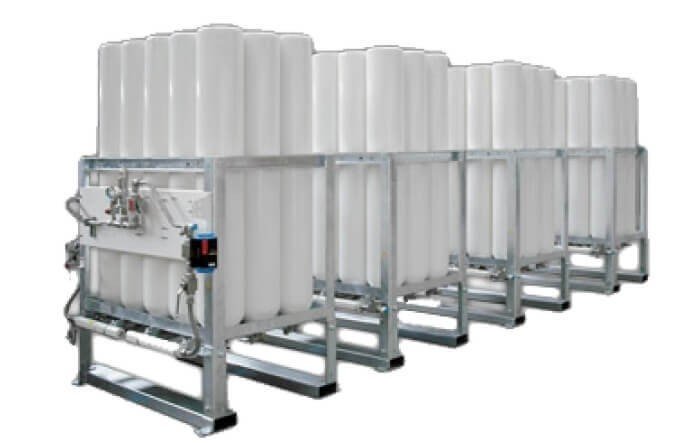

CNG Storage
In the pressure vessel market, there are a number of competing designs offered around the world, including a small number of new CNG Type V “linerless” designs, which have recently received regulatory approval for use in vehicle applications. A brief description of today’s five design types follows:
- CNG Type I: All-metal construction, generally steel.
- CNG Type II: Mostly steel or aluminum with a fiber-reinforced polymer overwrap in the hoop direction, featuring glass, carbon or basalt fiber; the metal vessel and wound composite materials share about equal structural loading.
- CNG Type III: Metal liner (typically aluminum) with full carbon fiber composite overwrap; the composite materials carry the structural loads.
- CNG Type IV: Metal-free construction. A carbon fiber or hybrid carbon/glass fiber composite is filament wound over a thermoplastic polymer (typically HDPE or polyamide) liner; the composite materials carry the structural loads.
- CNG Type V: An all-composite construction. The vessel is linerless, and features a carbon fiber or hybrid carbon/glass fiber composite wound over a collapsible or sacrificial mandrel; the composite materials carry all the loads.
Each type of pressure vessel has its benefits and liabilities. CNG Type I vessels are the least expensive, with estimated production costs of roughly $5 per liter of volume. The metalworking skills and equipment needed to produce them are widely available internationally. To their detriment, Type I vessels also are the heaviest, weighing approximately 3.0 lb/liter (1.4 kg/liter). By comparison, CNG Type II vessels cost about 50 percent more to manufacture but can reduce the weight of the storage containers by 30 to 40 percent. Type III and Type IV vessels take the weight savings even further, weighing between 0.75 and 1.0 lb/liter (0.3 to 0.45 kg/liter). The cost of Type III and IV vessels, however, is roughly twice that of Type II vessels and 3.5 times greater than Type I tanks. Types III and IV, moreover, are keys to the current growth equation for three reasons. First, constructing pressure vessels, in whole or in part, from composites reduces fuel system and vehicle weight. On a typical transit bus or commercial truck, for example, the use of Type III and Type IV vessels easily could reduce the weight of the gas containment system by more than 1,000 lb (454 kg). This weight reduction would not only improve fuel economy but also increase load-carrying capacity and introduce other operational benefits, making it possible for the more expensive tanks to buy their way onto vehicles. Second, composite vessels extend the practical limit for gas containment pressures and provide better energy storage density. For many high-pressure applications — requiring cylinders rated at 5,000 psi (344.7 bar) or greater — Type III and Type IV vessels represent the most practical solution. Third, composite materials significantly improve a pressure vessel’s corrosion resistance and overall safety. For composite vessels that incorporate carbon fiber tow as reinforcement, the excellent fatigue resistance of these fibers also extends the vessel’s service life. Carbon fiber-reinforced Type III and Type IV pressure vessels can remain in use for as many as 30 years before they require replacement — twice the interval allowed for Type I and Type II vessels.
New to the fray are Type V vessels. Certified in 2013, they represent the current state-of-the-art in terms of weight-to-pressure ratio. Composite Technology Development (Lafayette, Colo.) and Clean NG (Tulsa, Okla.) are reported to offer an additional 10 to 20 percent weight reduction compared to CNG Type IV vessels (Click on “Next-generation pressure vessels,” under "Editor's Picks," at top right). By virtue of the simplified laminate, it is believed, Type V vessels will eventually become less expensive options than the CNG Type III and IV vessels. And this is expected to be true despite some higher materials costs, owing to new toughened epoxy resin systems and the nanocomposites needed to prevent gas leakage in the absence of a liner.
Product Information:
CNG storage is refilled by a compressor up to 250 barg. It has two main functions:
- to store the compressed gas in order to optimize starts/stops of compressor and to speed up the first step of refilling of cars
- to damp pulsation coming from the compressor, avoiding those pulsations reach dispenser.
Features:
The main components of a CNG storage module are the following:
- Cylinders
- Inlet/Outlet Header(s)
- Interconnection tubings and fittings
- Valves and instruments
- Safety valves installed to protect the different levels of pressure The Assembly is CE-PED Certified
Applications:
Natural Gas Storage for any refilling station needs, available in a wide range of sizes
Storage Size:
- MAX water volume per rack: 18 x 80 liters = 1440 liters
- MAX rack dimensions: LxBxH = 2000 mm x 1050 mm x 2400 mm

